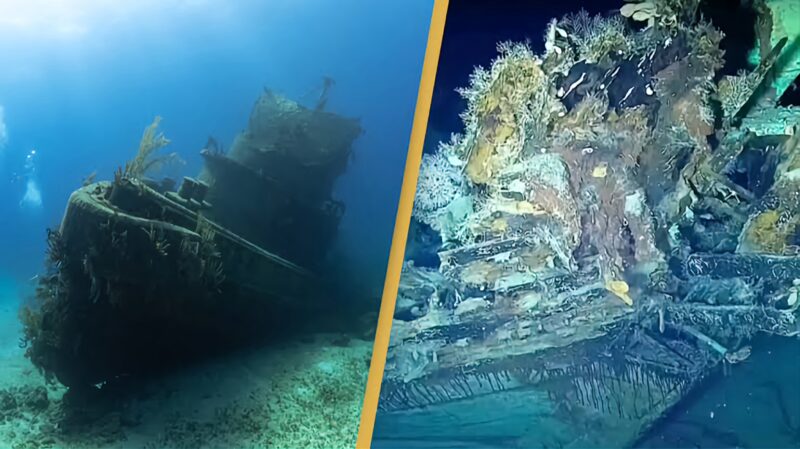Treasure Worth Billions Triggers Global Battle: Who Will Lay Claim to the Fabled Riches of the San José Shipwreck?
Over 300 years ago, the Spanish galleon San José “the holy grail of shipwrecks” met a fiery end off the coast of Cartagena, Colombia, after being sunk by a British warship in 1708.
Laden with a staggering cargo of gold, silver, and emeralds worth an estimated $7 to $18 billion today, the San José has earned the title of “the holy grail of shipwrecks.” Despite its discovery decades ago, fierce legal battles continue over who should claim ownership of the treasure resting on the ocean floor.
The San José remains one of the most contentious shipwrecks in history, with claims to its cargo being made by various parties, including the Colombian and Spanish governments, a U.S. salvage company, and indigenous groups from South America. Each stakeholder has a vested interest in either recovering or preserving the treasure, setting the stage for a complex and ongoing international legal dispute.
The Sinking of the San José
On June 8, 1708, the San José embarked on its fateful voyage from Panama toward Cartagena. It carried a vast wealth of precious metals and gemstones mined from Spanish colonies in South America. The ship was bound for Spain, where the treasure would help fund the Spanish War of Succession, a conflict raging across Europe between rival claimants to the Spanish throne.
However, the ship’s journey was abruptly cut short by British naval forces. During a heated battle, the British mistakenly fired a cannonball into the San José’s powder magazine, causing a massive explosion that sank the ship within minutes. Approximately 600 crew members perished in the wreck, which lay undisturbed on the ocean floor for centuries.
The shipwreck was first brought to public attention in the 1980s when a U.S. salvage company, Glocca Mora (now known as Sea Search Armada), claimed to have located it. However, negotiations with the Colombian government to recover the treasure quickly fell apart over disputes about how to split the proceeds, leading to a prolonged legal battle.
In 2015, the Colombian government independently announced the discovery of the San José in a different location from the one previously identified by Sea Search Armada. Since then, Colombia has maintained that it alone holds the rights to the ship and its contents, while Sea Search Armada continues to fight for its stake, arguing that it first located the wreck.
Who Owns the San José?
The competing claims to the treasure are further complicated by international law and historical ownership. Spain has asserted its rights to the San José, arguing that the galleon and its cargo are the property of the Spanish state, as they were part of the nation’s maritime fleet when it sank. According to Spain, the ship and its contents remain protected under the laws of sovereign immunity, which safeguard military vessels and their cargo from being claimed by others, even in the event of a shipwreck.
Indigenous groups from Bolivia and Peru have also staked their claims to the treasure, stating that the wealth carried by the San José was extracted from the mines of the Andes during Spanish colonization. Samuel Flores, a representative of the Qhara Qhara people of Bolivia, argues that the treasure belongs to indigenous communities, as it was taken from their lands by force.
“This cargo belongs to our people, the silver, the gold and we think it should be raised from the sea bed to stop treasure hunters looting it,” Flores said.
The Colombian government has expressed its desire to recover the San José and house it in a museum as part of the nation’s cultural heritage. Videos released by the government show the remains of the ship, including cannons, porcelain, and coins scattered across the sea floor, covered in marine life. However, this proposal has been met with resistance from archaeologists and historians, who argue that raising the shipwreck would destroy its historical integrity.
Carla Rahn Phillips, a maritime historian who has studied the San José extensively, points out that the ship is more than just a treasure trove. it is also a graveyard. The human remains of the 600 crew members who went down with the vessel make it a site of significant historical and emotional value. She argues that the wreck should be left in peace as a testament to the lives lost in the battle.
Archaeologists also stress that preserving the wreck in its current state is crucial for understanding its historical context. Rodrigo Pacheco Ruiz, a Mexican deep-sea diver who has explored numerous shipwrecks, cautions against the indiscriminate recovery of treasure from the San José. “If you just go down and take lots of artefacts and bring them to the surface, you just have a pile of stuff,” Ruiz says. “There’s no story to tell.” For him and other experts, the true value of the ship lies not in its commercial worth, but in the historical insights it offers.
The International Legal Battle
The legal battle over the San José has extended beyond national courts, reaching the international arena. Sea Search Armada has taken its case to the Permanent Court of Arbitration at The Hague, seeking compensation for its role in locating the ship.
Meanwhile, Colombia’s refusal to ratify the UNESCO Underwater Cultural Heritage 2001 Convention has made the legal framework for resolving such disputes even more opaque. The convention, which provides guidelines for the protection and preservation of shipwrecks, has not been universally adopted, leaving significant legal gaps when it comes to ownership and salvage rights.
According to Michail Risvas, an expert in maritime law, international law lacks clear-cut answers regarding the ownership of shipwrecks like the San José. While the United Nations Convention on the Law of the Sea provides some guidance, it offers little clarity when it comes to historical wrecks with valuable cargo.
The San José is far more than just a sunken treasure. it is a microcosm of historical, legal, and ethical questions that have yet to be fully resolved. As the legal battles continue, the ship remains at the bottom of the sea, an enduring reminder of a bygone era of empire, war, and colonization. Whether it will be raised and displayed in a museum, left undisturbed, or divided among claimants remains to be seen.










Join our Channel...